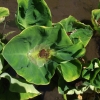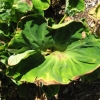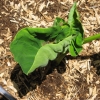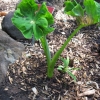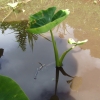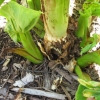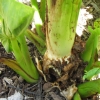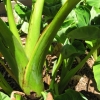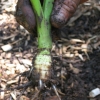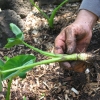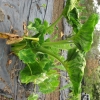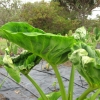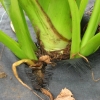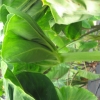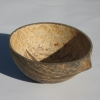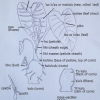Use As Food
This variety is now grown mainly for its leaves which are highly prized for lū ‘au. The leaf shapes like a bowl. The wai held in the leaves were reserved for only ali‘i to drink. The ‘i‘o kalo (Corm) makes good poi of very light color, soft in consistency, and easy to pound and prepare, and also serves as a good table taro.
Distribution
Essentially a lo‘i (wetland) taro although it is found in a few scattered localities in Kona under dryland culture (māla). Formerly it was widely planted, especially in Kohala, Hawai‘i. It is now sometimes found growing wild in wet places near the woods.
General Characteristics
Short, moderately spreading, very stocky, maturing within 6 to 9 months, producing from 5 to 10 ‘ohā; readily identified by the cup-shaped, definitely crinkled blades and light self-green Hā (Petiole).
Ha (Petiole)
35 to 50 cm. long, broad at kōhina (base), thick and rigid, fight green with white for 3 to 5 cm. above kōhina (base).
Lau or Lu'au(Leaf Blade)
35 to 40 cm. long, 25 to 35 cm. wide, 25 to 30 cm. from tip to base of sinus (māwae), horizontal, very crinkled and conspicuously cupped, medium green; piko and veins light green; round leaf section (lobes) obtuse, distinctly overlapping, with deep, narrow lihi māwae (sinus).
'I'o kalo (Corm)
Flesh white with indistinct, yellowish fibers; skin cream-colored.
Pua (Flower)
Hā (peduncle) light green; flower cover (spathe) usually loosely enclosing spadix (spike of flower) to kōhina (base) of plant, light green on lower tubular portion, the upper portion 20 to 25 cm. long, light yellow, usually open and ordinarily rolled only at the tip spadix (spike of flower) usually 17 to 20 cm. long. a spongy naked kōhina (base) with the ovulate portion extending along about 8 to 9 cm. and ovaries sparsely arranged on the lower part, the sterile appendage (tip of flower's spike) about 1 cm. long.
Remarks
31. ‘Apu and 30. ‘Apuwai are similar in appearance. The difference is ‘Apu.s lū ‘au (leaf) is more like a saucer compared to ‘Apuwai.s lū ‘au. ‘Aupwai.s lū ‘au is more cupped and folded over.

